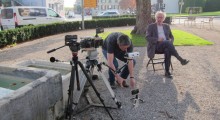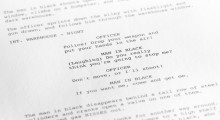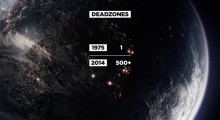6575 Results for “production”
-
Goodbye to 3-D Rules

To a degree, the content of Jean-Luc Godard’s Goodbye to Language will be familiar to viewers who have kept up with the director’s latter-day work: aphorisms and quotations by the score, obdurately unidentified characters whose relationship to each other is unclear, snatches of disparate music cued and cut off with disorienting abruptness. It’s not for everyone, but Godard’s first three-dimensional film is so visually astonishing that a lack of comprehension isn’t a barrier. Outdoors, sea and land stretch out into a receding horizon deeper than anything you’ve seen. Inside, there are more knockout distortions transforming even the most banal objects: […]
by Vadim Rizov on Oct 20, 2014 -
Filmmaking in Pairs: The Benefits of Directing Movies with Another Person (or Other People)

Filmmakers don’t get to be moody loners. If you’re a painter or a writer, you have the option to go it alone. Sit in your room, bang out that first draft. Or, lock the door, stretch the canvas and go to it. Film is different: It’s rarely a solo pursuit, especially at the feature level. As filmmakers, we’re forced out of isolation and compelled to rely on others: producers, editors, sound people, lawyers, distributors. We’re team players, whether we like it or not. Paradoxically, though, at the end of the day we have an “auteur-biased” rewards system. With many films […]
by Esther B. Robinson on Oct 20, 2014 -
Load & Play

Portrait of Jason Milestone Films — November 11 One-man show, fueled by one scotch bottle, in Shirley Clarke’s living room, one tough night only: Portrait of Jason is a spontaneous monologue delivered by hustler/aspirant cabaret artist Jason Holliday. Prompted and interrogated by a sometimes-exasperated crew, Jason is sharp on race and sex and self-deluding about himself. If his bravado is a necessary survival skill for survival as a queer black man in mid-20th-century America, there’s still a queasy charge in experiencing repeated whiplash as a viewer pinging back and forth between empathy and revulsion. This second volume in Milestone’s restorations […]
by Filmmaker Staff on Oct 20, 2014 -
The Limits of Quality Control: On Sticking with Mini-DV

There are many reasons why people get into making movies, but the fetishizing of gadgets might be my least favorite. Cheaper, higher-end video cameras make “quality” more attainable, but no matter how many pixels there might be in a high-definition image, it can’t make a story clearer. Yet, independent filmmakers are often drawn to the newest, hottest equipment, as if the barrier to making a decent movie can be scaled by stacking the latest and fanciest gear and climbing over. I’ve made four nonfiction features and, like a digital video Luddite, I’ve shot all of them with my trusty Panasonic […]
by Robert Greene on Oct 20, 2014 -
Vanishing Act: David Fincher on Gone Girl

Marriage might be an attempt at a lifelong emotional bond, but it’s also a contract enforced through mutual brutality. Disappointments mount, responsibilities shift, a struggle for power inevitably ensues between the partners; control is hard won and often gained only through compromises at best, coercion at worst. In most marriages, that brutality is only psychological, and the loss of the unmarried self — the version of you that attracted your significant other in the first place — never brings out the knives when you or your spouse realize what a lousy existence you’ve traded in for. (And we haven’t even […]
by Brandon Harris on Oct 20, 2014 -
Not an Option: The Ins and Outs of Shopping Agreements

The motion picture and television industries have become increasingly informal in recent years. In the past, agents would sign actors and writers before trying to sell their services or material, members of producing teams would sign collaboration agreements with their partners before taking a project to a studio, and producers would enter into written option agreements with writers under which they would pay money to exclusively option the motion picture and television rights to a property. These days, however, many agents will “hip-pocket” new artists and promote them without a contract to avoid commitment; a collaborator will walk a project […]
by Robert Zipser on Oct 20, 2014 -
Dispatches from Toronto & Camden

Toronto Film Festival 2014 By Scott Macaulay Early in Richard Glatzer and Wash Westmoreland’s resolutely unsentimental Still Alice, the eponymous Columbia University linguistics professor (Julianne Moore) visits a neurologist to discuss the memory issues she’s been having. “I’m going to tell you a name and address, and I want you to remember it,” he says. “John Black, 42 Washington Street, Hoboken.” After a few basic cognitive tests, he asks Moore to repeat the address. She stumbles, apologizes; she just got distracted. The doctor smiles and nods. Moore is brilliant in this scene, as she is throughout the film capturing, Kübler-Ross- […]
by Filmmaker Staff on Oct 20, 2014 -
Great Expectations: Alex Ross Perry on Listen Up Philip

Alex Ross Perry’s first feature Impolex was an oblique gloss on Thomas Pynchon’s Gravity’s Rainbow, while his higher-profile follow-up, The Color Wheel, stole the font of Philip Roth’s ’70s hardcovers for its credits, as well as that writer’s abrasive fearlessness and sexual disreputability. Literature hangs heavy over Listen Up Philip as well, not least in its subject: a young, New York novelist on the precipice of success being mentored by a Roth-like literary titan. That writer’s spirit is still present, but the major structural reference is William Gaddis’ behemoth debut The Recognitions, whose main through line is a pure-spirited and […]
by Vadim Rizov on Oct 20, 2014 -
Editing Today: Beyond the NLE

David Lean once called editing the soul of filmmaking. Today it’s more like the Mission Control. You’ve got to understand pixel counts, bit rates, bit depth, color sampling, sampling frequencies, frame rates, codecs, RAW files, deBayering, audio channels, waveform displays, vectorscopes, audio levels, LUTs, proxies, file-wrappers, Log gammas, XML, titling, effects — need I go on? Arcane stuff that used to be the domain of video engineers with EE degrees. To ensure a smooth and efficient postproduction “workflow” (term borrowed from I.T.), you must know about cameras too: which frame sizes they capture, which codecs they employ, which gammas they […]
by David Leitner on Oct 20, 2014 -
Charting the Course: Data Visualization in Documentary Film

“Every single pixel should testify directly to content.” So says Edward Tufte, a professor emeritus at Yale and pioneer in the field of data visualization. And if this emphasis on clarity and, essentially, story is true in the world of static infographics, it’s exponentially so when content comes at 24 frames per second. In the short PBS film The Art of Data Visualization, Tufte reaches far back in time, before the mundane pie charts and bar graphs that school children are taught to decipher, finding the beginnings of data visualization in stone-age cartography and the rise of science during the […]
by Randy Astle on Oct 20, 2014










